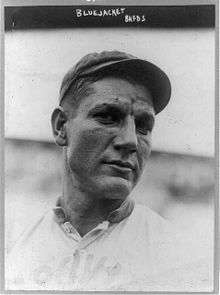Jim Bluejacket
Jim Bluejacket (born William Lincoln Smith July 8, 1887 – March 26, 1947) was a major league pitcher in the early 20th century. Bluejacket played for the Brooklyn Tip-Tops (1914-1915) and Cincinnati Reds (1916).
| Jim Bluejacket | |||
|---|---|---|---|
 | |||
| Pitcher | |||
| Born: July 8, 1887 Adair, Mayes County, Oklahoma | |||
| Died: March 26, 1947 (aged 59) Pekin, Illinois | |||
| |||
| MLB debut | |||
| August 6, 1914, for the Brooklyn Tip-Tops | |||
| Last MLB appearance | |||
| July 16, 1916, for the Cincinnati Reds | |||
| MLB statistics | |||
| Win–loss record | 14–17 | ||
| Earned run average | 3.46 | ||
| Strikeouts | 78 | ||
| Teams | |||
Personal life
When he started playing professional baseball in 1905 for the Sedalia Goldbugs in the American Association, he went by the name of Jim Bluejacket. After his playing days were over he continued to use his professional name as his legal name. In the 1900 U.S. Census records of Adair, Oklahoma his name was William L. Smith, son of William and Lucy (Dougherty) Smith. While playing for the Pekin Celestials of the Illinois–Missouri League in 1911 and 1912, he met Jennie Piro of Pekin, Illinois. They were married on December 31, 1912 in Carthage, Jasper County, Missouri and the wedding license reads that he was William L. Smith of Adair, Mayes County, Oklahoma. As late as June 5, 1917 he registered as William Lincoln Smith on his U.S. World War I draft registration card and stated that he was employed with the Bloomington ball team in Bloomington, Illinois.
Playing career
Bluejacket played for the Bloomington Bloomers for parts of the 1912, 1913, 1914, and 1916 seasons. While pitching for Bloomington at the age of 27 in 1914 he got the attention of the major league scouts by winning twelve games in a row and was signed by the New York Giants. But before he was to report to the Giants the Brooklyn Tip-Tops of the Federal League offered to pay him more and he signed with them. This caused quite a stir in New York with threats of injunctions between the two teams. He played his first game for the Tip-Tops on August 6, 1914 and compiled a 4-4 record the rest of the season. The Tip-Tops played in Brooklyn's Washington Park, which had been the home of the National League's Brooklyn Dodgers until 1912 when they moved to Ebbets Field.
While playing for the Tip-Tops, Bluejacket became the first major league pitcher to win a game without throwing a pitch. He came into the game against the Pittsburgh Rebels in the top of the ninth with two outs and a runner on first. Without throwing a pitch, he picked off the runner at first base for the third out and was credited with the victory after his team scored the winning run in the bottom of the ninth.
A member of the Cherokee nation,[1] Bluejacket was one of the first Native Americans to play Major League Baseball.
Legacy
Bluejacket's great-grandson is Bill Wilkinson, a relief pitcher for the Seattle Mariners in the 1980s. Bluejacket and Wilkinson are the only great-grandfather/great-grandson combination to play in the major leagues.
Bluejacket made a substantial contribution to the baseball scene on the island of Aruba. He was employed there for 15 years and devoted countless hours to the youth of Aruba and was instrumental in the founding of the Lago Sports Park there.
Bluejacket may have influenced other families besides his own to love the game of baseball. While Jim was playing for the Keokuk Indians of the Central Association in 1909 and 1910 his parents had a hired hand living with them in Adair by the name of Charles Edwin Mantle. Mantle later became the grandfather of the great Mickey Mantle. Charley most likely acquired a love of the game while living with the Smith family and sharing the news of their son, Jim Bluejacket.
References
- Mallozzi, Vincent M. (June 8, 2008). "The American Indians of America's Pastime". The New York Times. p. SP11. Retrieved June 10, 2008.
External links
- Career statistics and player information from Baseball-Reference, or Fangraphs, or Baseball-Reference (Minors)
- Jim Bluejacket at Find a Grave